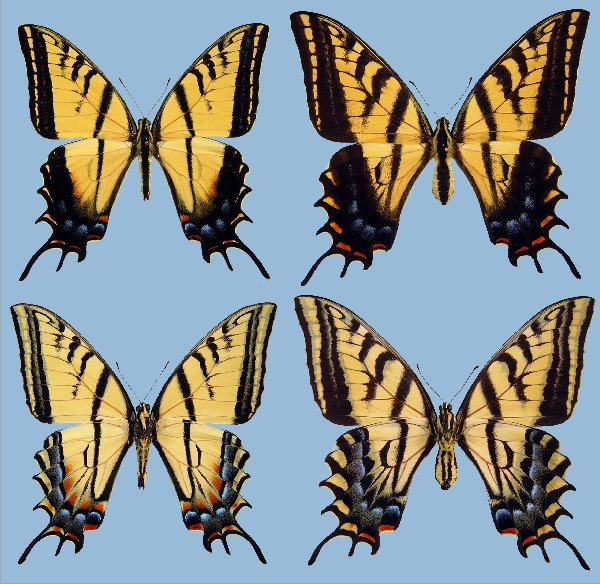Papilio multicaudata multicaudata

Photo Life History: Papilio mulitcaudata multicaudata
Habitat: Mountain Canyons; Valley Lakes & Rivers; Urban-Suburban;
Host Plants: Prunus virginiana; Prunus serotina; Fraxinus anomala; Fraxinus pennsylvanica.
Suitable Lab Host Plants: Older caterpillars are sometimes reluctant to switch from one of the above to another.
Caring for Live Female Butterflies: Feed females every day.
Methods of Female Oviposition: The open screen cages slide show demonstrates how this is accomplished for glaucus-group females, which, can be quite uncooperative for a few days when it comes to laying eggs in captivity. It's important to set them up in a cage where there is plenty of room to fly to and from the host plant. Also, provide nectar sources for females. Females also oviposit well in flight houses; the larger the flight house, the more cooperative the female to lay eggs.
How to Find Eggs: Look for immatures on isolated host plants, if at all possible. This is especially helpful in the Stansbury Mountains of Northern Utah because stands of choke cherry can grow in isolated pockets where eggs and larvae can be found.
How to Hatch Eggs: Consolidate eggs into one container.
How to Find Caterpillars in the Field: For earlier instars, look on the dorsal side of the leaf. For later instars, look for swallowtail pads. Finding glaucus-group caterpillars in numbers can be difficult and sometimes requires a certain degree of patience and hard work. Always remember to look for isolated host plants. Populations of black cherry (Prunus serotina) in Central and SE Arizona can be locally scarce creating ideal egg traps for females where caterpillars aren't too difficult to find.
Caterpillar setups: Open terrariums; Open Bucket.
Larva to Pupa: Larva purges and wanders; Larva Changes Color.
Number of Broods per Year: 1-3; depending upon location
Overwintering Stage: Pupa.
Overwintering Strategies: Your Own Backyard; Refrigerator
Post-Hibernation Strategies: Expose pupae to room temperature, long-day photoperiod and high humidity (mist spray them daily.)
Avoiding Diapause Techniques: Not applicable.
Disease Prevention: Change out host plant and remove frass every five to six days using the open terrarium technique.
Emergence: Emergence Container
Field Notes:

